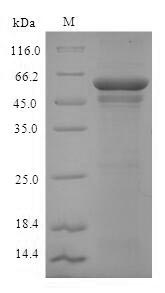Recombinant Arabidopsis thaliana Alcohol dehydrogenase class-3 (ADH2) is produced in E. coli and includes the complete mature protein sequence from amino acids 2-379. The protein carries an N-terminal 6xHis-tag, which makes purification straightforward. SDS-PAGE analysis shows the product achieves over 90% purity—a level that appears suitable for research applications requiring high-quality protein preparations.
Alcohol dehydrogenase class-3 (ADH2) from Arabidopsis thaliana catalyzes the conversion of alcohols to aldehydes, a reaction that's important in cellular metabolism. This enzyme likely participates in detoxification processes and helps plants adapt metabolically to stress conditions. For researchers working on plant biology, ADH2 may provide useful insights into enzymatic activity and how regulatory mechanisms function in plants.
Potential Applications
Note: The applications listed below are based on what we know about this protein's biological functions, published research, and experience from experts in the field. However, we haven't fully tested all of these applications ourselves yet. We'd recommend running some preliminary tests first to make sure they work for your specific research goals.
ADH2 is an enzyme that requires proper folding, formation of its active site, and binding of zinc cofactors for catalytic activity. While E. coli can successfully express some eukaryotic enzymes, the correct folding and functional activity of plant ADH2 cannot be guaranteed without validation. The protein may require proper cofactor incorporation and tertiary structure formation for bioactivity. No validation data (e.g., enzyme activity assays, circular dichroism) are provided. Therefore, the protein's folding status and bioactivity remain unverified, and applications should be considered conditional until functional validation is performed.
1. Biochemical Characterization of Plant Alcohol Dehydrogenase Activity
If the recombinant ADH2 is correctly folded and active, it can be used for in vitro enzyme assays to characterize biochemical properties and determine kinetic parameters using alcohol substrates and NAD+/NADH cofactors, as functional enzyme activity is essential for meaningful kinetic studies. However, if misfolded or inactive, such assays would yield inaccurate Km and Vmax values that do not reflect the enzyme's true catalytic properties, compromising biochemical characterization efforts.
2. Comparative Enzyme Evolution Studies
If properly folded and functional, ADH2 could serve as a reference for comparative studies across plant species to analyze evolutionary relationships and functional conservation, as valid comparisons require native enzyme activity and structure. However, if misfolded, any comparative data on catalytic efficiency or structural features would be misleading and not representative of biological evolution, leading to erroneous phylogenetic conclusions.
3. Antibody Development and Validation
This recombinant ADH2 can be used as an antigen for antibody generation regardless of folding status, as antibodies may recognize linear epitopes even in misfolded proteins. The high purity and full-length sequence support comprehensive epitope coverage. However, if misfolded, generated antibodies might not recognize the native, properly folded enzyme in biological contexts, limiting their utility for functional studies.
4. Protein-Protein Interaction Studies
If correctly folded, the His-tagged ADH2 could be used in pull-down assays to identify interaction partners from Arabidopsis extracts, as native conformation is necessary for biologically relevant protein interactions. However, if misfolded, there is a risk of non-specific binding or failure to recognize true biological partners, compromising the validity of identified interaction networks.
5. Structural and Biophysical Analysis
If properly folded, the recombinant protein is suitable for structural studies (e.g., X-ray crystallography) and biophysical characterization, as these techniques rely on native conformation to provide meaningful insights into structure-function relationships. However, if misfolded, structural data would misrepresent the native protein's architecture, leading to incorrect conclusions about the enzyme's mechanism and properties.
Final Recommendation & Action Plan
Before employing this recombinant ADH2 in any application, it is essential to validate its folding and bioactivity through enzyme activity assays using appropriate substrates and cofactors, along with biophysical characterization such as circular dichroism spectroscopy to confirm secondary structure. If validation confirms proper folding and function, proceed with applications while including appropriate controls, but if the protein is misfolded or inactive, consider using alternative expression systems (e.g., yeast or plant-based systems) that may better support proper folding and cofactor incorporation, or obtain a commercially validated standard to ensure reliable results in all proposed applications.






